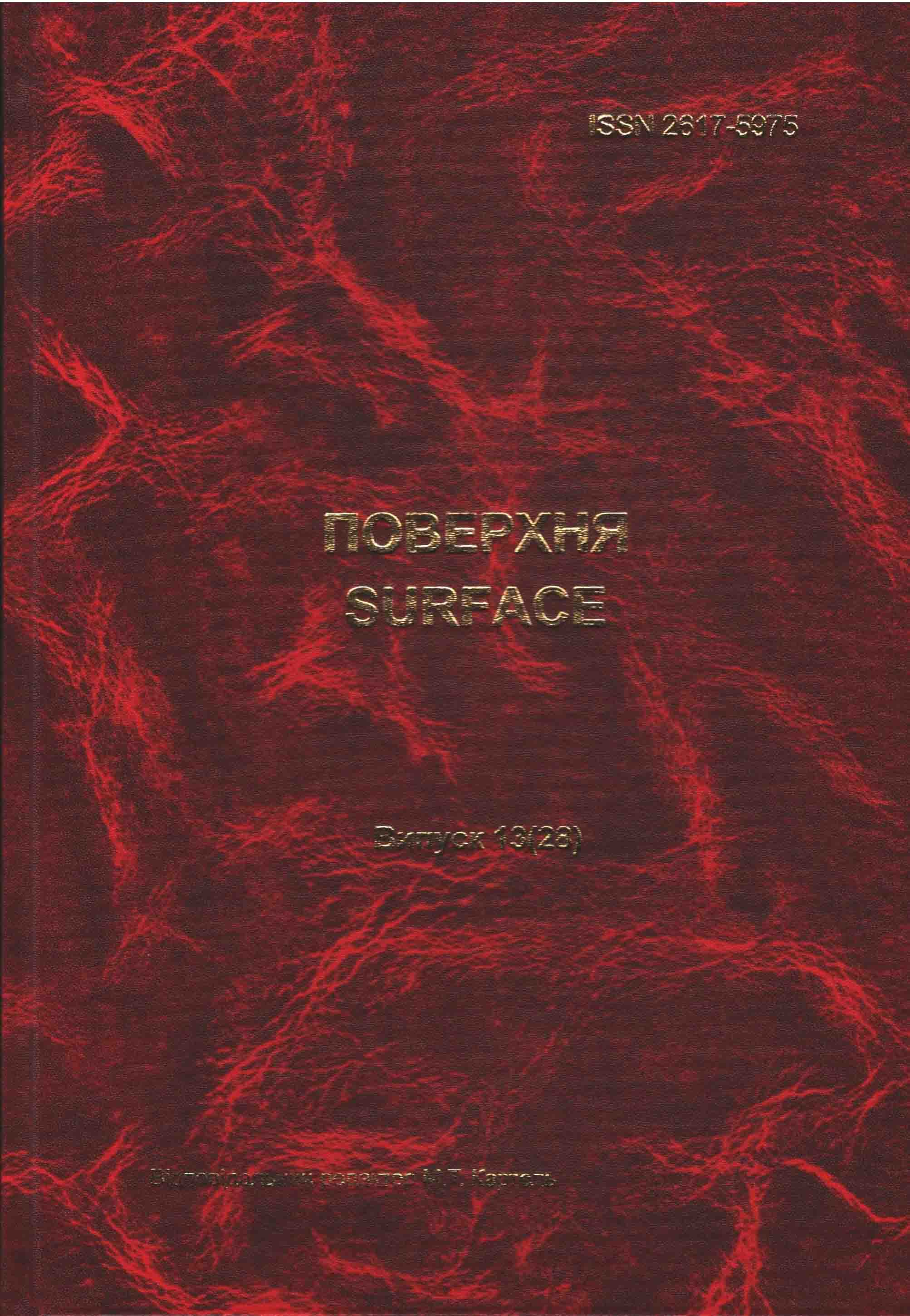Електронна структура комплексів олігомерів 3,4-етілен-діетоксітіофену з полістиролсульфоновою кислотою
Анотація
Методом теорії функціоналу густини (B3LYP, 6-31G**) розрахована електронна структура олігомеру 3,4-етилендіоксітіофену, що містить 12 ланок, у зарядових станах 0, +1, +2, +3 та +4. Показано, що саме олігомер з 12 ланок достатній для відображання властивостей провідного полімеру. Для оцінки ймовірності переміщення електронної густини вздовж ланцюга полімеру обчислена ширина енергетичної щілини між НОМО та LUМО. Показано, що молекули олігомерів EDOT і SS не залишаються паралельними один одному після комплексоутворення, а скоріше, зі збільшенням довжини ланцюга, перша поступово вигинається навколо аніонної одиниці SS; розподіл заряду в комплексах олігомерів EDOT і SS свідчить про присутність двох розділених поляронів на двох кінцях ланцюга, а асиметрія в розподілі заряду також передбачає наявність вигнутої спіральної структури утвореного комплексу.
Посилання
1. G.M.E. Silva, Electric-field effects on the competition between polarons and bipolarons in conjugated polymers, Phys. Rev. B 61 (2000) 10777-10781. https://doi.org/10.1103/PhysRevB.61.10777
2. S.S. Zade, M. Bendikov, Theoretical study of long oligothiophene dications: bipolaron vs polaron pair vs triplet state, J. Phys. Chem. B 110 (2006) 15839- 15846. https://doi.org/10.1021/jp062748v
3. N. Zamoshchik, U. Salzner, M. Bendikov, Nature of charge carriers in long doped oligothiophenes: the effect of counterions, J. Phys. Chem. C 112 (2008) 8408-8418. https://doi.org/10.1021/jp7111582
4. Yin H.-E., Huang F.-H., Chin W.-Y. Hydrophobic and flexible conductive films consisting of PEDOT:PSS-PBA/fluorine-modified silica and their performance in weather stability. J. Mater. Chem. 2012. 22(28): 14042. https://doi.org/10.1039/c2jm31352a
5. Heuer R.W., Wehermann R., Kirchmeyer S. Electrochromic window based on conducting poly(3,4-ethylenedioxythiophene)-poly(styrene sulfonate). Adv. Funct. Mater. 2002. 12(2): 89. https://doi.org/10.1002/1616-3028(20020201)12:2<89::AID-ADFM89>3.0.CO;2-1
6. Aleshin A.N., Williams S.R., Heeger A.J. Transport properties of poly(3,4-ethylenedioxythiophene)/ poly(styrenesulfonate). Synth. Met. 1998. 94(2) 173. https://doi.org/10.1016/S0379-6779(97)04167-2
7. Jonas F., Krafft W., Muys B. Poly(3, 4-ethylenedioxythiophene): Conductive coatings, technical applications and properties. Macromol. Symp. 1995. 100(1): 169. https://doi.org/10.1002/masy.19951000128
8. De Paoli M.-A., Casalbore-Miceli G., Girotto E.M., Gazotti W.A. All polymeric solid state electrochromic devices. Electrochim. Acta. 1999. 44(18): 2983. https://doi.org/10.1016/S0013-4686(99)00013-4
9. Cao Y., Yu G., Zhang C., Menon R., Heeger A.J. Polymer light-emitting diodes with polyethylene dioxythiophene-polystyrene sulfonate as the transparent anode. Synth. Met. 1997. 87(2): 171. https://doi.org/10.1016/S0379-6779(97)03823-X
10. Ouyang J., Chu C.-W., Chen F.-C., Xu Q., Yang Y. High-conductivity poly(3,4-ethylenedioxythiophene): poly(styrene sulfonate) film and its application in polymer optoelectronic devices. Adv. Funct. Mater. 2005. 15(2): 203. https://doi.org/10.1002/adfm.200400016
11. Yoshika Y., Jabbour G.E. Desktop inkjet printer as a tool to print conducting polymers. Synth. Met. 2006. 156(11-13): 779. https://doi.org/10.1016/j.synthmet.2006.03.013
12. Fan B., Mei X., Ouyang J. Significant conductivity enhancement of conductive poly(3,4-ethylenedioxythiophene): poly(styrenesulfonate) films by adding anionic surfactants into polymer solution. Macromolecules. 2008. 41(16): 5971. https://doi.org/10.1021/ma8012459
13. Dimitriev O.P., Piryatinski Y.P., Pud A.A. Evidence of the controlled interaction between PEDOT and PSS in the PEDOT:PSS complex via concentration changes of the complex solution. J. Phys. Chem. B. 2011. 115(6): 1357. https://doi.org/10.1021/jp110545t
14. Casado J., Hernandez V., Ramirez F.J., Lopez Navarrete J.T. Ab initio HF and DFT calculations of geometric structures and vibrational spectra of electrically conducting doped oligothiophenes. J. Mol. Struct.: THEOCHEM. 1999. 463(1-2): 211. https://doi.org/10.1016/S0166-1280(98)00416-3
15. Zade S.S., Bendikov M. Theoretical study of long oligothiophene dications: bipolaron vs polaron pair vs triplet state. J. Phys. Chem. B. 2006. 110(32): 15839. https://doi.org/10.1021/jp062748v
16. Zade S.S., Bendikov M. Twisting of conjugated oligomers and polymers: case study of oligo- and polythiophene. Chem.-Eur. J. 2007. 13(13): 3688. https://doi.org/10.1002/chem.200600819
17. Alemán C., Casanovas J. Theoretical investigation of the 3,4-ethylenedioxythiophene dimer and unsubstituted heterocyclic derivatives. J. Phys. Chem. A. 2004. 108(8): 1440. https://doi.org/10.1021/jp0369600
18. Agalya G., Lv C., Wang X., Koyama M., Kubo M., Miyamoto A. Theoretical study on the electronic and molecular properties of ground and excited states of ethylenedioxythiophene and styrenesulphonic acid. Appl. Surf. Sci. 2005. 244(1-4): 195. https://doi.org/10.1016/j.apsusc.2004.09.139
19. Dkhissi A., Beljonne D., Lazzaroni R., Louwet F., Groenendaal B. Modeling of the solid-state packing of charged chains (PEDOT) in the presence of the counterions (TSA) and the solvent (DEG). Theor.Chem. Acc. 2008. 119(4): 305. https://doi.org/10.1007/s00214-007-0384-5
20. Brédas J.L., Wudl F., Heeger A.J. Polarons and bipolarons in doped polythiophene: A theoretical investigation. Solid State Commun. 1987. 63(7): 577. https://doi.org/10.1016/0038-1098(87)90856-8
21. Kohn W., Sham L.S. Self-consistent equation including exchange and correlation effect // Phys. Rev. A., 1965., 140(4), 1133 https://doi.org/10.1103/PhysRev.140.A1133
22. Parr R.G., Yang W. Density-functional theory of atoms and molecules // Oxford: Oxford Univ. Press. - 1989. - 333 p.
23. Becke A. D. Density functional thermochemistry. III. The role of exact exchange J. Chem. Phys. 1993. 98. 5648. https://doi.org/10.1063/1.464913
24. Lee C., Yang W., Parr R.G. Development of the Colle-Salvetti correlation-energy formula into a functional of the electron density Phys. Rev. B. 1988. 37., 785. https://doi.org/10.1103/PhysRevB.37.785
25. Gangopadhyay R., Das B., Molla M.R. How does PEDOT combine with PSS? Insights from structural studies. RSC Adv. 2014. 4(83): 43912. https://doi.org/10.1039/C4RA08666J
26. Dkhissi A., Beljonne D., Lazzaroni R. Atomic scale modeling of interfacial structure of PEDOT/PSS. Synth. Met. 2009. 159(5-6): 546. https://doi.org/10.1016/j.synthmet.2008.11.022
27. Rumbau V., Pomposo J.A., Eleta A., Rodrigues J., Grande H., Mecerreyes D., Ochoteco E. First enzymatic synthesis of water-soluble conducting poly(3,4-ethylenedioxythiophene). Biomacromolecules. 2007. 8(2): 315. https://doi.org/10.1021/bm060949z
28. Ouyang J. Solution-processed PEDOT:PSS films with conductivities as Indium Tin Oxide through a treatment with mild and weak organic acids. ACS Appl. Mater. Interfaces. 2013. 5(24): 13082. https://doi.org/10.1021/am404113n





